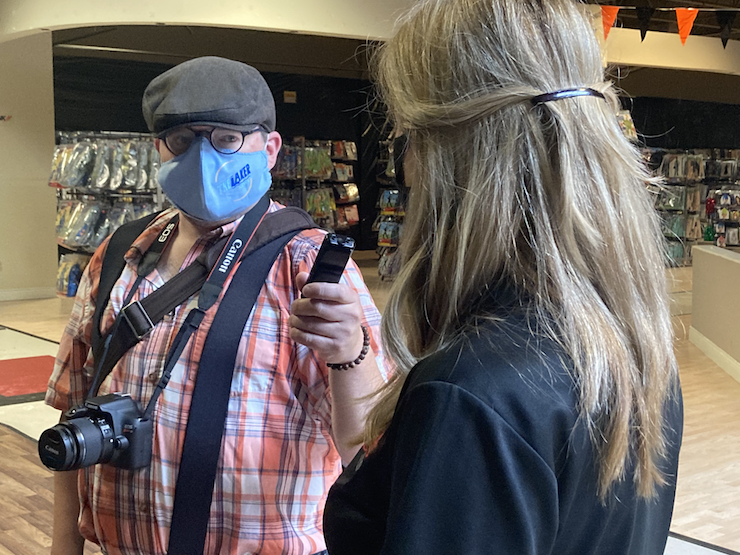Canada’s local news deserts

caption
A newspaper box is seen in a desert in this photo illustration.Local newsrooms are fast disappearing. Do they have a future?
It was the first time reporter Pat Healey was the story. In 2017, people from the rural Nova Scotia communities Healey covers raised $13,000 for his dentures. Dozens of people, including the local MLA, packed into a community hall for a celebration. Healey, who with his usual flat cap, suspenders and plaid resembles a fisherman more than a newsman, stood smiling in the corner surrounded by well-wishers.
Thank you, Healey told everyone.
No, they said, thank you.
That warm memory contrasts with the cold morning of Monday, January 6, 2020. Healey sat in a meeting at the Advocate Media office in Dartmouth. Executives announced his paper was closing. For the next two days, he thought about the different people he had met over the last 12 years. He couldn’t stop, he told himself, “it would feel like I was letting them down.”

caption
Pat Healey, 41, would ride his bike to The Laker newspaper office growing up and volunteer.The Advocate Media closure would create a local news desert. There are many across the country. In this case, nearly 35,000 Nova Scotians in Fall River, East Hants, Waverley, Beaver Bank and Musquodoboit Valley would not have any credible source of local information.
It’s a trend devastating Canadian journalism. According to the Local News Research Project, an initiative led by Ryerson University, 336 local new outlets across 236 communities have perished since 2008. More than 70 per cent were community newspapers – a daily or weekly with a print circulation below 50,000.
The COVID-19 pandemic delivered another blow. According to the Ryerson project, 2020 saw 48 community newspapers meet their demise.
“Local news plays a number of roles in communities,” said April Lindgren, a Ryerson journalism professor and the lead investigator on the Local News Research Project. Local news holds power accountable, builds community through common information, and leads to informed engagement.
No news is bad news
Jaigris Hodson worked with Lindgren on the Local News Research Project and leads the Masters of Arts in Interdisciplinary Studies program at Royal Roads University in Victoria, B.C. She researches how we use new technologies and social media. In 2015, journalism experts asked Hodson if technology and social media could support struggling local newsrooms, so she studied that October’s federal election.
Digital and social media, Hodson found, failed to balance local-riding and national coverage. Instead, national news trickled down and replaced local news. “We have a really major problem.” she said.
By looking at what people share online, Hodson discovered Canadians are starving for local information.
The current pandemic is the perfect example. Hodson believes people share whatever COVID-19 information they find. In local news deserts people desperate for information may only find fake news.
People don’t realize it, but they’re missing local news, Hodson said. “Even though they don’t have that understanding, they really are craving it.”
A demand for local news is how David Price came to run the Westmount Independent. Price isn’t a journalist; he’s a banker. But his father owned a small publishing business.
It began with calendars and guidebooks. Then came Viva, a successful lifestyle newsletter critiquing movies, books and food in Westmount, a suburb of Montreal.
People told Price to start a real newspaper. He responded, “We don’t do news. We just do reviews.”
The businessman in Price became curious and he saw an opportunity. In 2007, he started a newspaper that published twice a month. Within a year and a half, it was weekly.
The trick is uber-local content and good advertisers, says Price. Local is what affects our daily lives: sidewalks, roads, sewers, water, snow removal, parks, recreation, and local business. “Even though people don’t think they’re interested in local news,” he says, “they actually are. It’s not sexy.”
Little publisher that could
In rural Manitoba a chain of newspapers stays alive with local focus.
Lana Meier runs through the logistics of her operation – weekly newspapers in Selkirk, Stonewall, Morden-Winkler, Interlake, and Carman – with a graceful rhythm. There are just two offices. Her employees worked from home even before COVID-19.
Meier is a renaissance woman inside a fading art.
When she left Sun Media in 2010, Meier was the publisher of 12 weekly and two daily newspapers across Manitoba and northwestern Ontario. Later that year, she started the first three of her own papers and returned to the editorial desk.
By 2014, Sun Media had closed more than 20 of its papers and Meier started the fourth. While Postmedia closed rival papers in Selkirk, Carman, Interlake and Morden this year, Meier had the audacity to add a fifth paper during COVID-19. “Everyone thought we were crazy.”
Except the business community. According to Meier, every paper began after business owners begged her for local news. She responded, and so has the advertising.
“The success of the paper is making sure our local businesses have something the local people will pick up and read,” Meier said.
Her five papers have little presence on social media, and that’s no concern. “We spend our money to make sure we have quality journalism. We don’t fill the paper with stuff you can pull off the Internet.”
One-man show
Twenty-four hours after that bleak January meeting, Pat Healey’s phone rang. Two entrepreneurs – one is Healey’s mechanic – told the reporter they wanted him to keep reporting local news. If he needed anything when it came to the business side of the operation, they were happy to help. These supporters continue to assist Healey with things like invoices, taxes, and administrative duties. “I am very lucky.”
He’s very busy, too. Before the Advocate Media closure, Healey was a reporter. Now he is a reporter, editor, website administrator, and – the biggest change – sales representative. Advertising is new to Healey, but it pays his salary. He has to do it, he says.
It makes for long hours.
“I’ve stopped counting,” Healey said. Passionate about his job, he feels he has to maintain a certain level of coverage in his region. It remains to be seen how long he can keep this up.
“I’d be lying if I said I wasn’t worried.”

caption
Healey started his online news site during the COVID-19 pandemic and says, ‘it’s been a struggle.Local news poverty
“Local news desert” doesn’t capture the entire problem facing local journalism, says Ryerson’s April Lindgren. She prefers “local news poverty.”
“The idea of a desert implies there’s nothing there. No news,” Lindgren said. Most parts of Canada are affected by closures, but differing levels of radio and television coverage may remain for some. Certain communities are also absorbed into a neighbouring newspaper’s regional coverage.
“Poverty,” she says, looks beyond the have and have-nots. It’s more than quantity; it’s quality too. This perspective, said Lindgren, shows which communities are more impoverished than others in terms of critical information.
Drastic cuts to Canadian newsrooms have eviscerated staff and resources. According to a 2018 survey by Lindgren and the non-profit National NewsMedia Council, a self-regulatory body for Canadian news media founded in 2015, community newspaper reporters are facing increasing pressures and longer hours. Forty per cent reported working at least 50 hours a week.
As fewer people do more work, burnout threatens Canadian journalists. As Lindgren says, “journalists tend to have a commitment to their communities that goes beyond showing up and getting their paycheque.”
For journalists who still have jobs, serving their communities is increasingly difficult.
The new news
Some Canadian journalists are trying something new. The award-winning website the Sprawl launched before Calgary’s 2017 municipal election. Jeremy Klaszus freelanced for large news outlets in the city, but opportunities were drying up as newsrooms shrank. He saw a void in civic affairs reporting.
Three years later the Sprawl is crowd-funded by more than 1,600 people who contribute $5 or more every month. This stable source of revenue builds a relationship with readers. Klaszus, the editor-in-chief, wants to offer more in-depth content than the daily news cycle. “The idea is to do stories other media aren’t doing.”
The operation is modest: two full-time employees, two part-time, and a reliance on freelancers. Klaszus has plans to grow, but knows he’ll need more than monthly contributions.
In 2018, Ottawa promised $595 million to support the media sector and struggling newsrooms. Jaigris Hodson is concerned this funding won’t reach alternative outlets like the Sprawl. New and old forms of local news, Hodson said, need more than crowdfunding to survive.
Lindgren agrees. Local newsrooms will survive off a combination of revenue sources: government subsidies, subscriptions, advertising and philanthropy. The old model is broken.
Lindgren still wants to research the effects of local news poverty in Canada. Consequences of mass closures have emerged south of the border. The United States has lost 2,000 local newspapers in the last 16 years. This has left a local news desert in 200 counties.
Studies show that these areas saw declines in local and state voter turnout. Government costs went up in some communities – without journalists telling residents how their taxes were being spent.
For Lindgren, the problem isn’t saving community newspapers.
“We have to save local journalism,” she said. “It has to be journalism that is accessible to everybody.”

